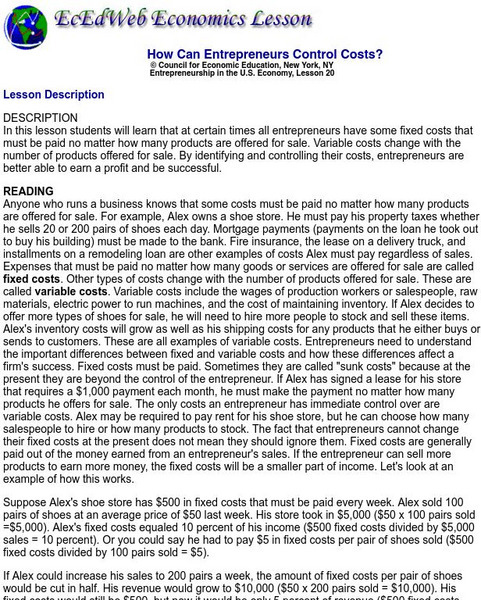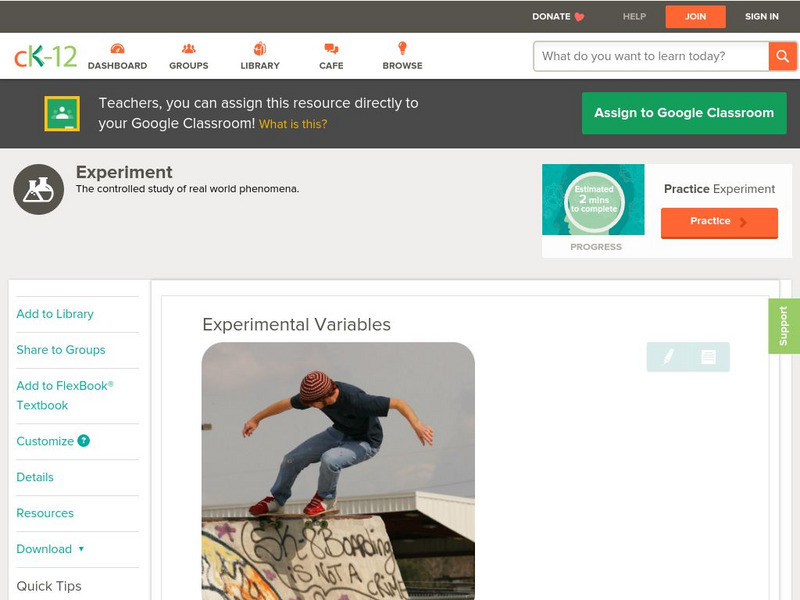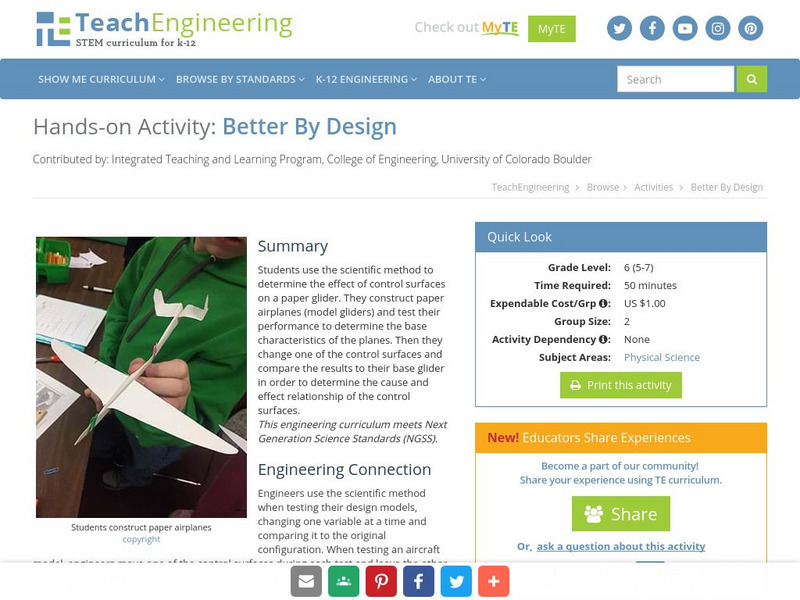Sophia Learning
Sophia: Control and Variable Groups: Lesson 1
This lesson will explain the difference between a control group and variable groups, when using the scientific method. It is 1 of 4 in the series titled "Control and Variable Groups."
University of Nebraska Omaha
Ec Ed Web: How Can Entrepreneurs Control Costs?
This economics activity explores what influences producers to supply in regard to demand. It examines fixed and variable costs, how such costs can be reduced, and how they influence production. Includes printable worksheets.
Science Education Resource Center at Carleton College
Serc: Catapults: Controlled Investigations
In this structured inquiry, students will investigate a catapult system. Having previously explored and identified the variables of the catapult system (length of lever, mass of shot, angle of catapult), students will conduct controlled...
TeachEngineering
Teach Engineering: Are You in Control?
This lesson teaches the engineering method for testing wherein one variable is changed while the others are held constant. Young scholars compare the performance of a single paper airplane design while changing the shape, size and...
American Chemical Society
Inquiry in Action: Crushing Test
This lab activity will have students crushing crystals to learn about variables and the importance of controlling those variables. Lab activity includes student and teacher instructions.
Cosmo Learning
Cosmo Learning: Control Engineering
A collection of video lectures from an industrial control course taught at the National Programme on Technology Enhanced Learning. The course teaches basic characteristics of feedback control systems, frequency-response analysis, and...
Sophia Learning
Sophia: Independent/dependent Variables: Lesson 1
This lesson will explain the difference between independent and dependent variables. It is 1 of 4 in the series titled "Independent/Dependent Variables."
Texas Education Agency
Texas Gateway: Experimental Design
Given investigation scenarios and lab procedures, students will identify independent variables, dependent variables, constants, and control groups.
Khan Academy
Khan Academy: Storing Data in Variables
Find out how computer programs instruct computers how to process data.
TeachEngineering
Teach Engineering: Balsa Glider Competition
The purpose of this activity is to bring together the students' knowledge of engineering and airplanes and the creation of a glider model to determine how each modification affects the flight. The students will use a design procedure...
Khan Academy
Khan Academy: Storing Strings in Variables
When we're making a program, we often want to store sequences of letters. In programming lingo, we call each letter a character and we call the sequence a string.
CK-12 Foundation
Ck 12: Scientific Method
[Free Registration/Login may be required to access all resource tools.] Describe how the Renaissance period in history changed the approach to science. Identify the steps of the scientific method. Differentiate between the independent...
TeachEngineering
Teach Engineering: Mint Mobiles
Students design, build and test model race cars made from simple materials (lifesaver-shaped candies, plastic drinking straws, Popsicle sticks, index cards, tape) as a way to explore independent, dependent and control variables. They...
CK-12 Foundation
Ck 12: Chemistry: Scientific Experiments
[Free Registration/Login may be required to access all resource tools.] Experiments, experimental variables, and experimental controls are discussed.
TeachEngineering
Teach Engineering: Students as Scientists
This curricular unit contains two lessons that let students actually do the work of scientists as they design their own experiments to answer questions they generate. In the first lesson and its associated activity, students conduct a...
PBS
Pbs Teachers: Daredevil Ball Jump Ii Experiment
Make alterations in the variables of the original ZOOM Daredevil Ball Jump activity by heating or cooling the balls in the experiment. Predict how the balls' bounces will be affected by hot and cold, test the predictions and record the...
CK-12 Foundation
Ck 12: Biology: Science Experiments
[Free Registration/Login may be required to access all resource tools.] Covers the scientific experimental design.
Texas Instruments
Texas Instruments: Designing a Reaction Rate Experiment
In this activity, students will design, conduct, and report the outcome of an experiment in which they investigate some factor that affects the rate of reaction between baking soda and vinegar. The dynamic nature of the reaction, coupled...
TeachEngineering
Teach Engineering: Better by Design
The purpose of this activity is to use a scientific method to determine the effect of control surfaces on a paper glider. The students will construct a paper airplane/glider and test its performance to determine the base characteristics...
TeachEngineering
Teach Engineering: Will It Fly?
In this lesson plan, students will learn about kites and gliders and how these models can help in understanding the concept of flight. Students will design and build their own balsa wood models and experiment with different control...
Michigan State University
Michigan State University: Lets Net: Growing Plants Unit
In this unit, learners can learn about the affects of water, soil, and sunlight on plant's growth while learning about the scientific process. Unit allows students to create a controlled experiment while studying plants.
Khan Academy
Khan Academy: Polygenic Inheritance and Environmental Effects
Learn about traits that are controlled by multiple genes and/or influenced by the environment. Understand penetrance and expressivity.
Science Education Resource Center at Carleton College
Serc: Inquiry: How Herbs Change Based on Growing Conditions
In this activity, students will develop writing, math, and inquiry skills by investigating the taste of basil. Students will test basil in different growing conditions while also comparing it to a controlled variable. Students will then...
Cengage Learning
Cengage Learning: Project Based Learning: Egg Drop Experiment
Students are challenged to design a way to drop a raw egg from varying heights without letting the egg break. Creative thinking and evaluation of results are critical to the project.

























